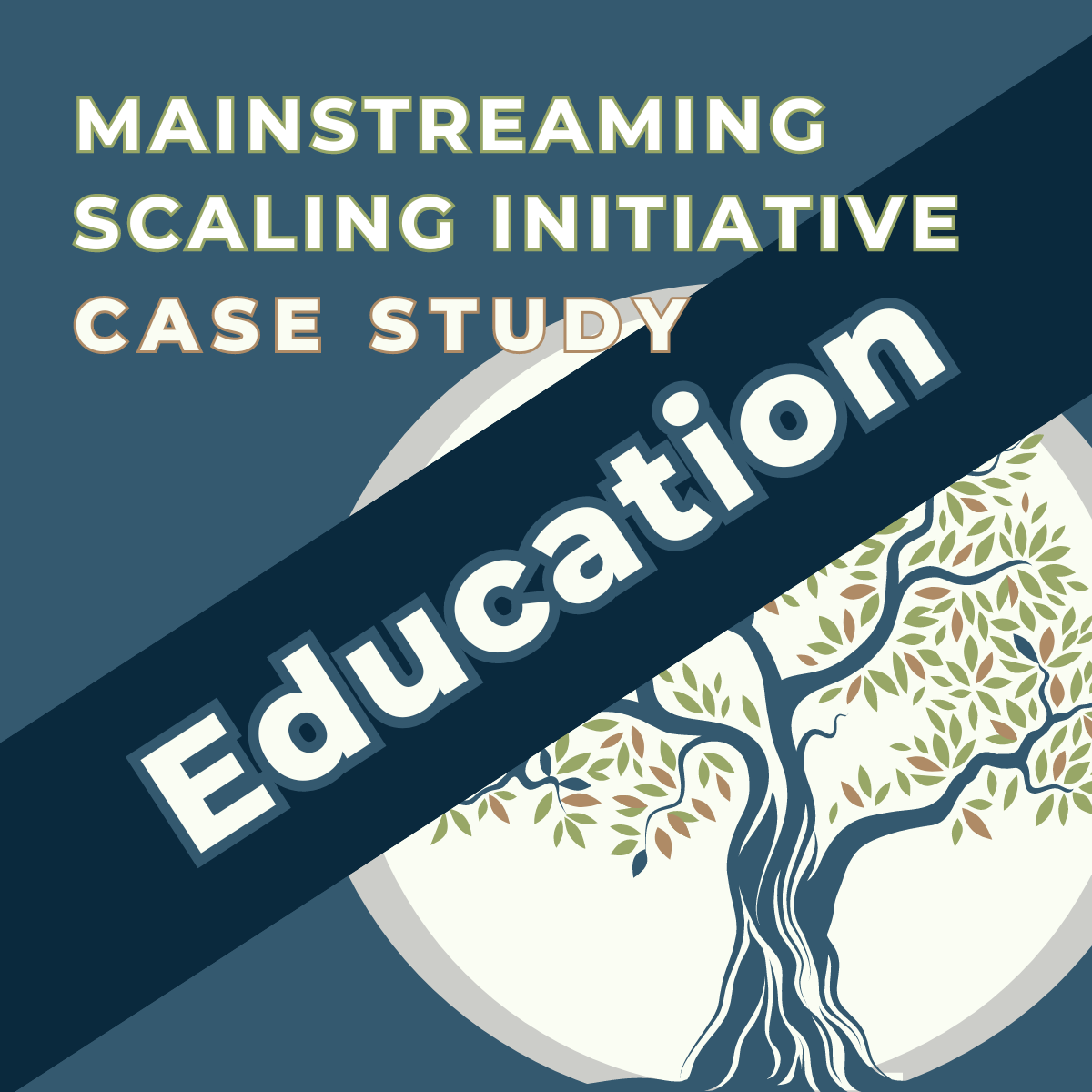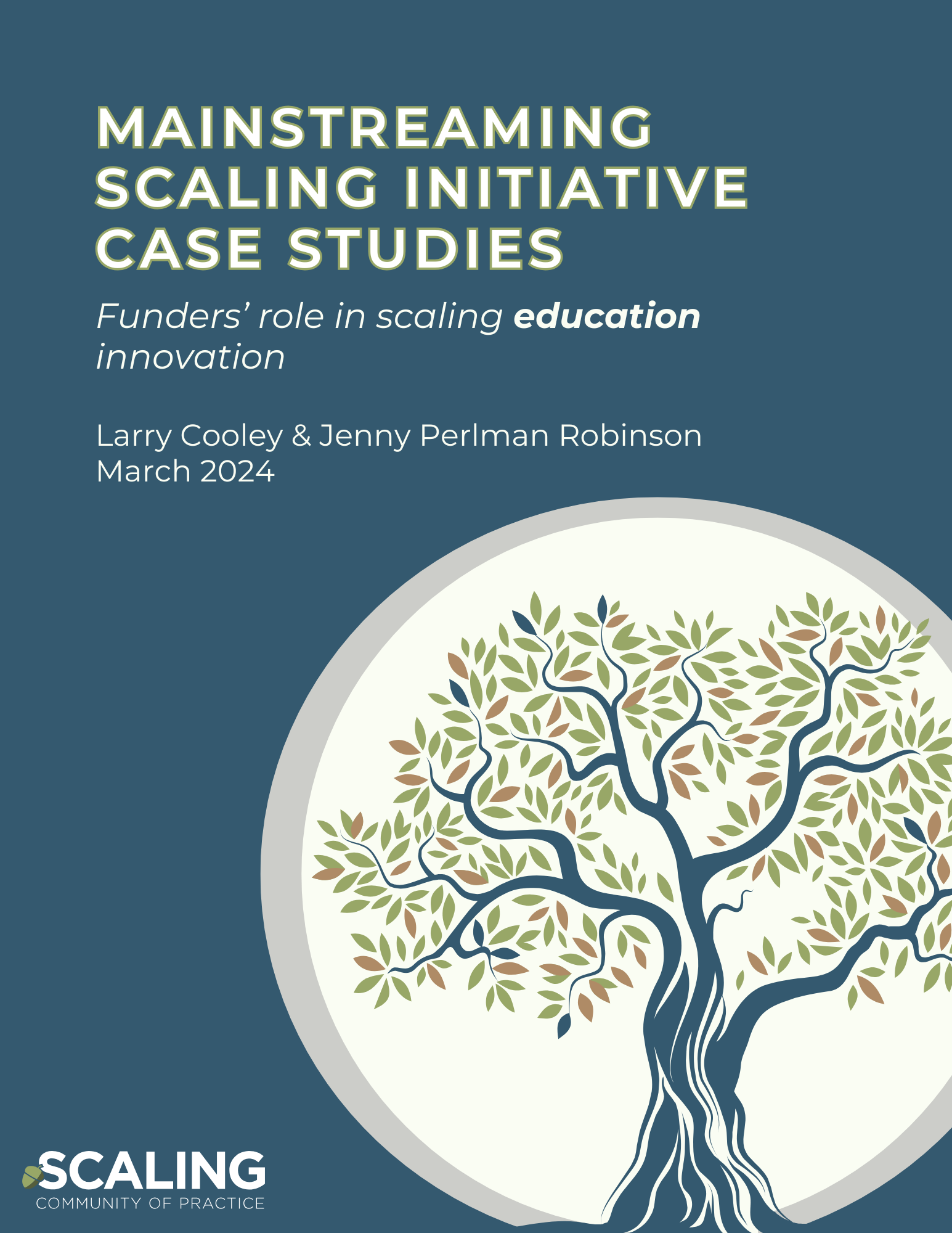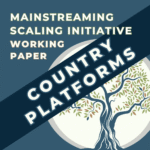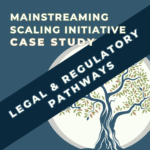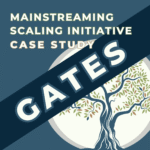Preface
The Scaling Community of Practice (CoP) launched an action research initiative on mainstreaming scaling in funder organizations in January 2023. This initiative has three purposes: to inform the CoP members and the wider development community of the current state of support for and operationalization of scaling in a broad range of development funding agencies; to draw lessons for future efforts to mainstream the scaling agenda in the development funding community; and to promote more effective funder support for scaling by stakeholders in developing countries. (For further details about the Mainstreaming Initiative, see the Concept Note on the COP website).
The Mainstreaming Initiative is jointly supported by Agence Française de Développement (AFD) and the Scaling Community of Practice (CoP). The study team consists of Richard Kohl (Lead Consultant and Project Co-Leader), Johannes Linn (Co-Chair of the Scaling CoP and Project Co-Leader), Larry Cooley (Co-Chair of the Scaling CoP), and Ezgi Yilmaz (Junior Consultant). MSI staff provide administrative and communications support, in particular Leah Sly and Gaby Montalvo.
The principal component of this research is a set of case studies of the efforts to mainstream scaling by selected funder organizations. In addition, a limited number of cross-cutting sectoral and thematic reviews are being prepared. The present paper focuses on the experience with funders’ support for scaling in the education sector. It was prepared by Larry Cooley, Co-Chair of the Scaling Community of Practice and Jenny Perlman Robinson, Senior Lead, Innovation and Growth, Youth Impact and Nonresident Senior Fellow, Brookings, as an in-kind contribution to the Scaling Community of Practice.
Note: An earlier version of this commentary was published on the Brookings Institution website.
CLICK HERE TO READ MORE
Funders’ role in scaling education innovation
Education systems have been quick to teach about innovation and painfully slow to innovate in the way we teach. Our research suggests that the problem does not reflect a lack of promising new practices but rather a failure to scale most of those improvements. Fortunately, that has begun in recent years to change; however, we believe much more can, and must, be done.
The Millennium Development Goals (MDGs) and, subsequently, the Sustainable Development Goals (SDGs), called for major increases in government expenditure on education, targeting an increase to 20 percent of national budgets. Also targeted were significant increases in access (with a special focus on girls), quality, equity and relevance. The intended budget increases have occurred in many countries as have the goals for expanded access. Much less evident have been the intended improvements in quality, equity or relevance. Given the limited scope for additional funding increases, the logic “give us more money and we will educate more children” will need to be replaced by an aggressive search for increased productivity and enhanced effectiveness, delivered equitably and sustainably at scale.
While donor funding represents less than one percent of overall education financing as compared to national expenditures and household spending, national budgets are dedicated almost entirely to teacher salaries and school infrastructure. As a result, external funders often provide a large portion of the sector’s discretionary budget and those external funders, therefore, can have a significant impact on helping to seed and take an innovation to scale.
We have been investigating for several years the role of external funders in supporting enhanced education outcomes at scale. We have done so in two ways: through a 4000-member community of practice focused on scaling development outcomes, and through the Millions Learning project. This commentary summarizes some of the insights from this work related to the role of funders in scaling education interventions. It discusses patterns observed among education funders in their efforts to support the mainstreaming, or integration, of education innovations within an existing education system and points to where further progress is needed to achieve large-scale and lasting improvements in children’s learning. In this piece, “education funders” refers to philanthropic donors representing foundations, innovation funders, and bilateral and multilateral donors.
Here are five observations we have made about the current state of practice related to funders’ roles:
1. Intermediation—connecting smaller innovations to larger-scale delivery—is an under-resourced, yet critical area, ripe for funders’ support.
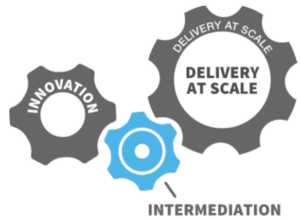
Figure 1. Innovation Value Chain in Education Source: Authors’ adaptation of The Broken Part of the Business Model in Taking Development Outcomes to Scale
The graphic above is one way of thinking about the mainstreaming of new policies and practices within an education system. On the left-hand side, the smaller gear represents experimenting, piloting, and confirming the efficacy of education innovations. This is where NGOs and funders tend to concentrate. The right-hand side, and largest gear, is typically the government’s domain-delivering education to all children.
The challenge—and where things tend to break down—is in the middle, the blue gear depicting the “intermediation tasks” necessary for connecting innovations with large-scale delivery. These tasks include investment packaging, policy, and budget advocacy, facilitating agreement among diverse stakeholders, and project planning. In the absence of institutions that are able, motivated, and positioned to perform these tasks, the vast majority of promising innovations never transfer to the larger gear and therefore fail to address the scope of the educational challenges faced. We believe this is a place where external funders can play a particularly important role.
2. Education funders have embraced the narrative of scaling, but this hasn’t translated into widespread changes in policies and practices.
Scaling as a goal increasingly appears in funders’ strategies and plans, and some have moved beyond rhetoric to enacting operational changes in their grantmaking. This has been particularly pronounced in some foundations. For example, the Jacobs Foundation decided nine years ago to consolidate their grantmaking in a few cocoa producing countries and focus on mainstreaming a limited number of evidence-based interventions selected by national governments and responding to local needs. With similar aspirations, Co-Impact designed its grants to support systemic change by making investments in sometimes intangible and longer-term efforts, such as building coalitions for change, strengthening organizational capabilities, and incentivizing adaptive learning.
At the same time, there has been growing recognition among funders and their critics that scaling requires not only more money, but changes in how that money is allocated and structured. In some cases, this has translated into funders giving larger tranches of more flexible funding and/or extending their funding over longer periods of time. In other instances, funders have focused beyond project implementation and more tangible outputs to strengthening field building and key organizational capacities in service of broader impact.
Where this has happened, the benefits have been clear. For example, in the case of Ahlan Simsim —a joint venture between Sesame Workshop and the International Rescue Committee (IRC) supported by the MacArthur and LEGO foundations in response to the Syrian crisis—significant increases in the numbers of communities reached and outcomes achieved didn’t happen until year four, when interventions designed with government ministries launched. Analysis by IRC’s Ahlan Simsim team indicates one of the core enablers of this was the long-term and flexible nature of the financing (see Figure 2).

However, changes in donors’ practices remain limited. Organizational inertia and existing incentives contribute to a reality where one-and-done projects lasting one to five years remain the rule, not the exception; metrics continue to focus on direct beneficiaries; partners during project planning rarely prioritize those organizations that will be responsible for implementation and delivery at scale; and government concurrence is frequently mistaken for government ownership. An additional, ironic consequence of the increased emphasis on scaling is greater pressure and perverse incentives to scale prematurely.
3. Funders have varying approaches to collaboration and partnership, which impacts how they view their role and how they approach financing.
We have witnessed a more nuanced understanding of scale and systems change and transformation emerging among the education funder community. However, we have also noted considerable differences among funders in their respective concepts of scale and scaling. These different conceptualizations have direct and profound implications on how resources are allocated and how initiatives are designed, implemented, and monitored.
Intellectually, funders understand that sustainable scaling requires a shift in how institutions function, incorporating changes in policies, procedures, and organizational culture. They also seem to appreciate that this takes time, pragmatism, political savvy, and collaboration. Nevertheless, most persist in their efforts to scale project-based interventions in their entirety rather than scaling specific components or aspects, and most maintain a focus on direct delivery rather than changes that contribute to broader systems change. This shortcoming is compounded by the fact that, in too many places, fragmentation has increased with growth in the number of funders with the unintended result that it is ever more common for funders to support multiple groups doing very similar work in the same place and pass opportunities to pool or leverage their investments, collaborate, and work through government systems. The incentives for NGOs and other innovators reflect donor policies and, therefore, similarly encourage differentiation rather than integration.
4. Much has been learned about innovative financing of the “middle stage” of scaling.
Encouragingly, the global education community is learning much more about navigating the “middle phase of scaling” after piloting and expansion but before reaching sustainable delivery at scale. This period, often referred to as the valley of death, is where many promising innovations die. It is a period typically longer and more political in the education sector than in other sectors given the dominant role of government policies and budgets and the semi-autonomous behavior of schools and teachers. Historically, this has been challenging for funders for many reasons, including short-term project cycles, changing strategies, and desires for attribution and branding. Equally challenging is the political economy of transitioning from external funding to government budgets or other sustainable sources.
But the number and range of positive examples are growing. The five case studies investigated as part of the Millions Learning Real-time Scaling Labs manifest different and successful strategies for navigating this valley of death aided, in each case, by innovative injections of flexible financing during this middle phase. For example, in Jordan, a financial education program delivered across all secondary schools has been financed by a public-private partnership between the government, foundations, and a levy on the profits of commercial banks. This long-term, reliable financing was critical in driving the scaling process forward. In each case, these investments were relatively large and for longer-than-usual periods of time, and each was accompanied by technical support for developing scaling strategies from the start; resources for intermediary partners to assist with developing scaling plans, facilitating collaborative learning and documenting lessons; and flexibility to change course as needed. We have come to believe that this type of funding may well be required to navigate this middle phase of scaling, and we are optimistic that funders are beginning to absorb this reality.
5. In their enthusiasm to achieve scale, funders have often emphasized “proven solutions” without adequate attention to local solutions and contextualization.
Unlike more technology-based sectors, evidence-based breakthroughs have been relatively few in the education sector leading funders to channel their investments into identifying and promoting “good buys” or “what works” at the global level and transferring these solutions to new localities. This has proven to be effective, at times, in addressing common challenges, with cost- and time-savings by leapfrogging pilot phases and drawing on existing experience and evidence. For example, in efforts to improve literacy and numeracy in early grades, several countries have adapted a version of Teaching at the Right Level approach, which was pioneered by Pratham in India and rigorously tested and refined in partnership with the Jameel Poverty Action Lab, including through six randomized controlled trials over 15 years.
At times, however, this approach of promoting global best practices has also inadvertently contributed to narrowing the focus of innovation to a set of “solutions” that countries are encouraged to adopt. As discussed in CUE’s report, Government decision-making in low- and middle-income countries, “Because of the prevalence of importing external innovations (called ‘education transfer’ in the literature), close attention to deep contextualization becomes paramount—but this is expensive, takes times, and requires a degree of flexibility often not available. The more significant the adaptations required, the more expensive the innovation can be to scale; as a result, there is a perceived trade-off between contextualization and speed/cost-effectiveness.”
Despite this perceived trade-off, increasingly, there are successful efforts to adapt existing innovations to local contexts. For example, Youth Impact, an NGO based in Botswana, has utilized A/B testing (a method of delivering different versions of a program to randomized groups to determine the better performing variation) to rigorously and rapidly test and optimize an approach for improving early grade numeracy and literacy in Botswana. Youth Impact has undertaken more than 25 rapid tests in 36 months to continuously iterate and develop the most cost-effective variation of an existing innovation adopted from elsewhere.
For these reasons, increased research and documentation regarding the trade-offs and adaptation associated with successful cross-context transfer should be, in our opinion, a priority for funders to support.
The education funder community has made much progress in recent years in adopting a systematic approach to sustainable scaling. However, there is still much to learn—and much to do—if mainstreaming these approaches is to become standard practice and the “new normal.” We believe that immediate actions education funders can take include:
- Adopt internal procedures in support of sustainable scaling, including 10–15-year time frames, flexible funding, encouragement of collaborative partnerships, and adaptive learning.
- Prioritize during design and implementation the development of scaling plans that serve as “living documents” and are developed collaboratively with those who will be responsible for delivering and financing at scale.
- Acknowledge the distinction between government concurrence (i.e., a ministry allowing an NGO to implement a program in government schools) and government ownership (i.e., a ministry dedicating budget and personnel to deliver a program over time, at scale), and adopt strategies for ensuring genuine government ownership of innovations.
- Focus measurement on indirect beneficiaries and institutionalization of change, de-emphasizing direct attribution and branding of specific innovations.
- Enhance attention to, and funding for, intermediation in support of services, such as the development of scaling strategies, coalition building, investment packaging, field strengthening, documentation, and sharing of lessons learned.
At the current pace, the world will fall far short of achieving the Sustainable Development Goal of ensuring all children have access to quality education and lifelong learning by 2030. We are unlikely to close the gap by relying exclusively on quantitative expansion of current practices and on the current practices of funders without also introducing and scaling an array of impactful and cost-effective innovations and a range of new funder strategies. Evidence is accumulating that donors are beginning to acknowledge these realities, but much remains to be done to translate these lessons into practice.
